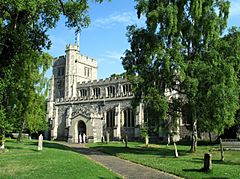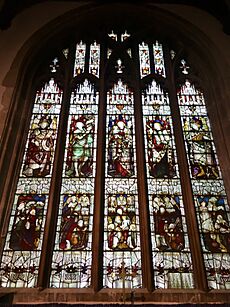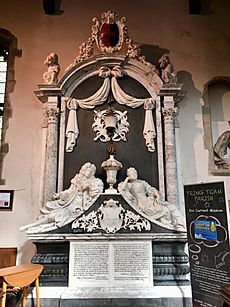Church of St Peter and St Paul, Tring facts for kids
Quick facts for kids Church of St Peter and St Paul |
|
|---|---|

Viewed from the south-east
|
|
| 51°47′40.2″N 0°39′39.9″W / 51.794500°N 0.661083°W | |
| OS grid reference | SP 924 115 |
| Location | Tring, Hertfordshire |
| Country | United Kingdom |
| Denomination | Church of England |
| Architecture | |
| Heritage designation | Grade I |
| Designated | 21 September 1951 |
| Administration | |
| Diocese | Diocese of St Albans |
The Church of St Peter and St Paul is a beautiful old church located in Tring, a town in Hertfordshire, England. It's part of the Church of England, which is a Christian church. This special building is considered a 'Grade I listed building,' meaning it's very important and protected because of its history and architecture. Even though it was fixed up a lot in the late 1800s, most of the church was built way back in the 1400s!
Contents
History of the Church
People believe there was a church here as early as the year 1100, during the Norman times. You can still see a few stones in the outside walls of the chancel (the part of the church near the altar) that show how the Normans shaped them. The church was rebuilt in the early 1200s. It was constructed using rough flint stones and blocks of Totternhoe stone, which is a type of limestone. Later, some parts were replaced with Ancaster stone.
In the 1300s, the church got wider aisles (the side sections where people sit). A tall tower was also added, which has a small turret and a special kind of spire called a Hertfordshire spike. The south porch, which is the entrance on the south side, also dates from the 1300s, though it was repaired in 1880. The fancy arch of the south door is even older, from the 1200s.
During the 1400s, the older arches inside the church were replaced with new ones, creating six bays (sections). The arch leading to the chancel and the clerestory (the upper part of the nave walls with windows) were also built around this time. The chancel itself was partly rebuilt in the 1500s. Three windows in its south wall are from this period, but a narrow window in the north wall is from the 1200s.
Church Restoration Work
The church underwent a big restoration project between 1861 and 1882. During this time, the north aisle was rebuilt. The columns that held up the arches, made of Totternhoe stone, were found to be unsafe. So, they were replaced with stronger columns made of Portland stone.
In 1862, the old pews were replaced with new oak seating. The beautiful carved ends of the seats and the oak pulpit were designed by an architect named William Slater. The impressive oak rood screen, which separates the nave from the chancel, was made in 1899. It was designed by G. F. Bodley. He also designed the painted and gilded ceiling of the chancel. The large painting above the chancel arch was created in 1899 by a company called Messrs Powell of London. The stained glass windows at the east and west ends of the church were made by Clayton and Bell. The east window was put in place in 1851. The west window has an arch from the 1300s.
The font, which is a basin used for baptisms, was given to the church in 1862. It is made from colourful Streetly stone.
Important Monuments
In the north aisle, you can see a marble monument dedicated to Sir William Gore (who lived from 1644 to 1707) and his wife Elizabeth. This monument was moved here from the chancel in 1882. People think it was created by a famous sculptor named Grinling Gibbons or his student John Nost. The monument shows Sir William Gore, wearing his robes as the Lord Mayor of London, and his wife lying on either side of a large funeral urn.
Close by, also in the north aisle, is another marble monument. This one is for Sir William's son, John Gore (who lived from about 1689 to 1763). This monument was also moved from the chancel in 1882.
Church Bells
The church has eight bells in its tower. The two smallest bells were made in 1882 by a company called Gillett and Bland. The other bells are much older, from the 1600s and 1700s. The largest bell, called the tenor bell, was made in 1695 by Richard III Chandler. It is very heavy, weighing about 890 kilograms!
War Memorial
In front of the church, there is a war memorial. It was paid for by people donating money from the community. This memorial was officially dedicated in November 1918. It is believed to be the very first war memorial in the entire country that was built to remember those who lost their lives in the First World War.



